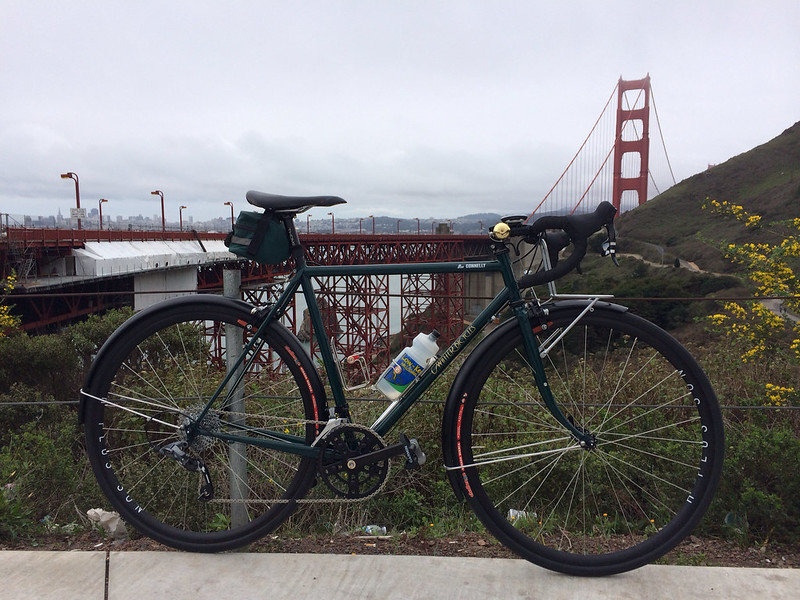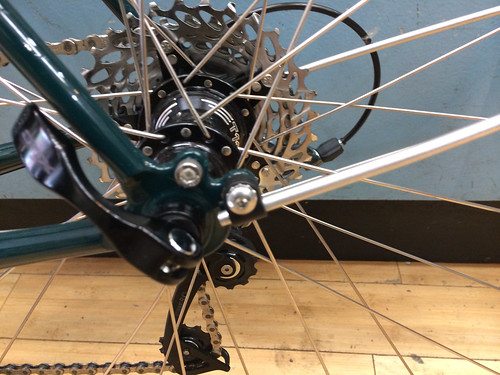Winter Allaban part 10: shake-down
Continued from last time...
After leaving home I took off for the Embarcadero, where there is an extended section of cobblestones along the MUNI rail tracks. I was really looking forward to how the 30 mm nominal, 32 mm measured Strada Bianca tires and high-rake fork took the rough surface compared to my road racing bikes.
And, of course, it handled it quite well. But it was still somewhat uncomfortable. No super-plush ride like that Jan Heine likes to brag with his 42 mm by 650B tires on his custom Rene Herse (Boulder Bikes). But I was fine with that.
After the cobbles, I came to the Maritime Museum. There's some vestigal tracks here, no longer used, which can cause issues for narrow tires. I rolled over these tracks, even at a relatively oblique angle, without problem. The wider rubber was much more forgiving.
Fort Mason was next. This is a short, relatively steep climb which gave a chance to see how it went up. And it passed: the geometry, despite being smaller trail than I've ever ridden before, tracked nicely. It was really fun being on this bike.
Jan Heine likes to talk about bikes which "plane", his word for when the frame flexes with the pedal-stroke, sort of a frame-flex version of eccentric chainrings. Indeed, he likes bike with exceptionally narrow tubes to maximize this flex. The tubes on this bike are light, but not as thin as the ones Jan prefers. I don't know if I felt any "planing", but it certainly felt good enough on the Fort Mason climb.
For the descent, I took the dirt trail which goes around the green at Fort Mason rather than the conventional paved route. It did well on the dirt. No problem with debris getting caught between the tires and fenders.
I did notice one thing at Fort Mason, however, which was that there was overlap between my shoe and the fender. Jan Heine would not approve but it doesn't bother me much. The first road bike I owned had ferocious overlap and I quickly learned not to turn my front wheel into my foot. It's second nature, to my detriment mountain biking, because you need to do this when riding around switchbacks. Mountain bikes obviously are not designed with overlap. But while this bike is for many things, I don't plan to ride it through too many switchback turns.
The next test was the Golden Gate Bridge. Going around the bridge supports invaraibly provides a cross-wind challenge. and while the winds weren't strong on this day, I still got a feel for how it handled in the cross-winds. Jan Heine argues that low-trail geometries work well in cross-winds for two reasons. One is that the lever arm of for the wind force against the front wheel relative to the steering axis is less if the rake is less. Additionally, the steering moment induced by bike lean is less if the trail is less. So generally lower trail will result in less of a steering challenge with gusting cross-winds than larger trail. The bike passed no problem.
Across the bridge I paused in the parking lot to take this photo:

Now was the time for some legitimate climbing. I took the bike up the Conzelman climb. This winds its way up the hillside just north of the Golden Gate Bridge. It's a fantastic climb, unfortunately diminished by an excess of tourist car traffic. I tried to maintain a steady effort here, but my time was slow. No magical power boost offsetting the greater gravitational burden! But then my legs were tired from running, and my cycling was off from neglect.
I got to the top without issue. Then came the equally interesting test: descending the west side. The west side of Counzelman is a one-way narrow, winding, steep descent with world-class views of the rugged coastline. But the focus wasn't ont the views, but rather how the bike handled. And the answer was very well. I wonder if the 2 cm of extra handlebar width helped a bit with the control, but a greater factor was the low trail, which in theory contributes to the bike steering with less effort than longer trail bikes. Meanwhile the relatively fat tires provide more confidence, that if I hit a pothole or rock on my descent it's far less likely to take me down.
Counzelman descends to a sharp right turn onto Field Road took me past some buildings from the old army base, down past the visitor center, and then onto Bunker Road. Bunker Road, heading back east, is a gradual uphill grind. I've never made a real effort here. The real climbing begins later.
The usual way for a road bike is to turn right on McCullough. McCullough is a steady, moderately steep climb, also with excellent views, back to the logical half-way point of the Counzelman climb I'd already done. But before the turn onto McCullough there's an alternate route: the Coastal Trail's steady, moderately graded climb to the McCullough-Counzelman junction. Recent rains had left the trails slightly damp, and my bike was shiny clean, but the bike was bought to be ridden so I decided to see how I did here.
First, I paused just past the gate to where the climbing starts to take a quick shot. I think this photo captures the spirit of the bike nicely:

Then I set off. First, immediate disappointment, not in the bike but in myself. The flow from the rains had left ruts in the trail, ruts which could catch a skinny tire. My tires were a bit less skinny (although still so by Jan Heine standards) and should have been able to handle the surface. But I dismounted, in shame. Oh, the shame....
Back on the bike, I started climbing again. The bike was handling the trail very nicely. Then, just as I hit a relatively rough part of the trail... a rattling sound. I tried to ignore it. Surely it was just an anomaly and would go away any second. But of course it didn't. My momentum was lost. I had to stop.
And this is what I saw:
One of the fender screws had come loose. Obviously having a fender stay flap around in the breeze wasn't the best idea: I wanted to find that lost screw. It had been attached with a lock washer, but perhaps I'd failed to tighten it enough. Or better yet, perhaps I should have used Loc-Tite.
I backtracked, slowly, to the start of the rough section. That must have been where the screw came free. Then I went a bit further. No luck finding the small screw on the dirt. So I turned around and retraced my pedal strokes back up the trail. Still no luck. This wasn't going to work.
I decided to ride carefully the rest of the trail then try to find a piece of string or wire to clamp the stay shut. Then I'd stop at Box Dog Bikes on the way home and get a proper replacement. The ride to the top went without incident: the loose stay didn't appear to be a hazard of flying into the spokes. I regretted that I'd failed to replace the zip tie I normally carry in my tool bag the last time I'd used it, which was to ironically fix a fender on my rain bike (an old Trek 1500). A zip tie would have solved the problem.
I made it to the top of the trail then began the paved descent of Counzelman. This also went fine. At the bottom is a parking lot where I thought I had a good chance to find something useful. So I searched the dirt verge to the parking lot. It was strewn with strange pieces of flimsy string, obviously left over from some construction project or something. But they were too old and flimsy to work. Maybe a paper clip or wire would turn up. I didn't find one, but instead I found.... a bolt.
Surely the bolt wouldn't work: the threads would be wrong. But I had to give it a try. I put the bolt up against the C-clamp holding the fender stay in place and gave a turn. It mated without difficulty. Amazing!
It was long, but there was clearance, and the fender stay was held in place better than ever:

the rest of the ride home went without incident. Along the way, as planned, I stopped at Box Dog where admiration was expressed for the bike and a screw and lock washer were donated. I made sure to tighten it this time, as well as its mate on the opposite side.

From this and a following loose bolt experience, I've concluded that especially for the primary fender bolt at the fork crown, Loc-Tite is the best approach. For the stay bolts, at least I can easily check those for looseness, but I'll probably Loc-Tite those as well.
So the shake-down ride accomplished it's nominal goal: the bike was shaken and a weakness was identified. But the ride was fantastic. I couldn' wait to take it out again. My only regret was that my training is focused on running right now, so truly worthy adventures will need to wait.

Comments